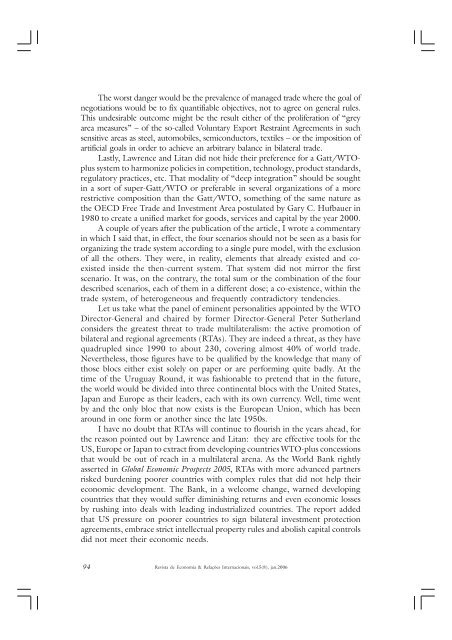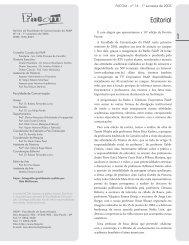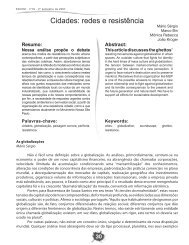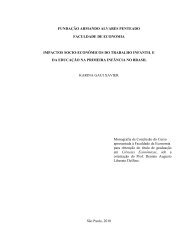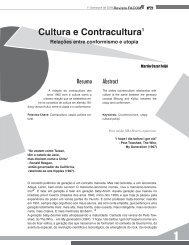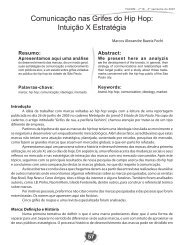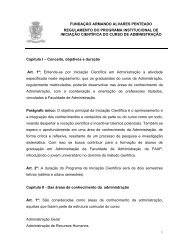Número 8 - Janeiro 2006 - Faap
Número 8 - Janeiro 2006 - Faap
Número 8 - Janeiro 2006 - Faap
You also want an ePaper? Increase the reach of your titles
YUMPU automatically turns print PDFs into web optimized ePapers that Google loves.
The worst danger would be the prevalence of managed trade where the goal of<br />
negotiations would be to fix quantifiable objectives, not to agree on general rules.<br />
This undesirable outcome might be the result either of the proliferation of “grey<br />
area measures” – of the so-called Voluntary Export Restraint Agreements in such<br />
sensitive areas as steel, automobiles, semiconductors, textiles – or the imposition of<br />
artificial goals in order to achieve an arbitrary balance in bilateral trade.<br />
Lastly, Lawrence and Litan did not hide their preference for a Gatt/WTOplus<br />
system to harmonize policies in competition, technology, product standards,<br />
regulatory practices, etc. That modality of “deep integration” should be sought<br />
in a sort of super-Gatt/WTO or preferable in several organizations of a more<br />
restrictive composition than the Gatt/WTO, something of the same nature as<br />
the OECD Free Trade and Investment Area postulated by Gary C. Hufbauer in<br />
1980 to create a unified market for goods, services and capital by the year 2000.<br />
A couple of years after the publication of the article, I wrote a commentary<br />
in which I said that, in effect, the four scenarios should not be seen as a basis for<br />
organizing the trade system according to a single pure model, with the exclusion<br />
of all the others. They were, in reality, elements that already existed and coexisted<br />
inside the then-current system. That system did not mirror the first<br />
scenario. It was, on the contrary, the total sum or the combination of the four<br />
described scenarios, each of them in a different dose; a co-existence, within the<br />
trade system, of heterogeneous and frequently contradictory tendencies.<br />
Let us take what the panel of eminent personalities appointed by the WTO<br />
Director-General and chaired by former Director-General Peter Sutherland<br />
considers the greatest threat to trade multilateralism: the active promotion of<br />
bilateral and regional agreements (RTAs). They are indeed a threat, as they have<br />
quadrupled since 1990 to about 230, covering almost 40% of world trade.<br />
Nevertheless, those figures have to be qualified by the knowledge that many of<br />
those blocs either exist solely on paper or are performing quite badly. At the<br />
time of the Uruguay Round, it was fashionable to pretend that in the future,<br />
the world would be divided into three continental blocs with the United States,<br />
Japan and Europe as their leaders, each with its own currency. Well, time went<br />
by and the only bloc that now exists is the European Union, which has been<br />
around in one form or another since the late 1950s.<br />
I have no doubt that RTAs will continue to flourish in the years ahead, for<br />
the reason pointed out by Lawrence and Litan: they are effective tools for the<br />
US, Europe or Japan to extract from developing countries WTO-plus concessions<br />
that would be out of reach in a multilateral arena. As the World Bank rightly<br />
asserted in Global Economic Prospects 2005, RTAs with more advanced partners<br />
risked burdening poorer countries with complex rules that did not help their<br />
economic development. The Bank, in a welcome change, warned developing<br />
countries that they would suffer diminishing returns and even economic losses<br />
by rushing into deals with leading industrialized countries. The report added<br />
that US pressure on poorer countries to sign bilateral investment protection<br />
agreements, embrace strict intellectual property rules and abolish capital controls<br />
did not meet their economic needs.<br />
94 Revista de Economia & Relações Internacionais, vol.5(8), jan.<strong>2006</strong>


